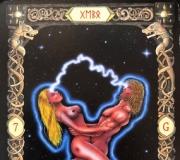The concept of literary etiquette in ancient Russian literature. Literary etiquette in the chronicle
(1) Basically the text of this chapter is a report submitted for publication in 1962. See: Slavic literature. Reports of the Soviet delegation. V International Congress of Slavists (Sofia, September 1963). M., 1963; and separately. S. Wolman wrote about the system of genres before me, but in application to theatrical and dramatic genres; For references to these works by S. Wolman, see his article: The system of genres as a problem of comparative historical literary criticism (Problems of modern philology. M., 1965. P. 344). In Soviet literary criticism and folklore literature, the concept of a “system of genres” spread after my report at the V International Congress of Slavists in 1963.
Recently, the genre system has been discovered and has begun to be successfully studied in ancient Russian art. A wonderful book by G. K. Wagner “The Problem of Genres in Old Russian Art” (Moscow, 1974) appeared on this topic. In it, the genres of ancient Russian art are studied in the same way as a system, and this system is compared with the one that existed in ancient Russian literature, and very important similarities and differences are revealed. Referring those interested to this book, we only note that in ancient Russian art we find both the functional principle of genre formation (p. 30), and their subordination to aesthetic etiquette (p. 36), and much more, confirming and deepening our ideas about the aesthetics of Ancient Rus'.
II THE POETICS OF LITERARY GENERALIZATION
LITERARY ETIQUETTE
Feudalism at the time of its emergence and flourishing, with its extremely complex ladder of vassalage-suzerainty relations, created a developed ritual: church and secular. The relationships between people and their relationships with God were subject to etiquette, tradition, custom, and ceremonial, developed and despotic to such an extent that they permeated and to a certain extent took over the worldview and thinking of a person. From public life, a penchant for etiquette penetrates into art. Images of saints in painting are to some extent subject to etiquette: iconographic originals prescribe the image of each saint in strictly defined positions, with all the attributes inherent to him. The depiction of events from the lives of saints or events of sacred history was also subject to etiquette.
The iconographic subjects of Byzantine painting largely depended on the etiquette of the feudal court. The entire third part of A. Grabar’s work “The Emperor in Byzantine Art” is devoted to the influence of court ritual on the formation of the main iconographic types - such as the entry of the Lord into Jerusalem, the Deesis, the descent into hell, the Almighty seated on the throne, etc.
In addition to painting, etiquette can be revealed in the construction art of the Middle Ages and in applied art, in clothing and in theology, in relation to nature and in political life. This was one of the main forms of ideological coercion in the Middle Ages. Etiquette is inherent in feudalism; life is permeated with it. Art is subject to this form of feudal coercion. Art not only depicts life, but also gives it etiquette forms.
If we turn to the literature and literary language of the era of early and developed feudalism, then here too we will find the same tendency towards etiquette. Literary etiquette and the literary canons developed by it are the most typical medieval conventional normative connection between content and form.
In fact, V. O. Klyuchevsky picked up quite a lot of formulas, supposedly specifically inherent in the hagiographic genre. A. S. Orlov did the same for the genre of military stories. There is no need to list these formulas; they are well known to every specialist: “grabbing the hands of the slaughter,” “blood flows through the fields like a river,” “the knocking and noise is terrible, like thunder,” “beating hard and mercilessly, like groaning the earth,” “and poltsi, like a boar”, etc. However, neither A. S. Orlov nor V. O. Klyuchevsky attached importance to the fact that both hagiographic formulas and military formulas are constantly found outside of lives and outside military stories, for example in the chronicle , in a chronograph, in historical stories, even in oratory and in messages. And this is very important, because it is not the genre of the work that determines the choice of expressions, the choice of formulas, but the subject matter in question. It is the object in question that requires certain stencil formulas for its image. Since we are talking about a saint, hagiographic formulas are mandatory, whether it will be spoken about in a life, in a chronicle, or in a chronograph.
(1) Grabar A. L"Art imperial et l"art chretien /U In: Qrabar A. L"Empereur dans l"art byzantin. Paris, 1936.
(2) See: Klyuchevsky V. O. Old Russian Lives of Saints as a Historical Source. M., 1871.
(3) See: Orlov A.S.: 1) On the peculiarities of the form of Russian military stories (ending the 17th century) Ts CHOIDR. 1902, book. IV, pp. 1-50;2) About some features of the style of Great Russian historical fiction of the 16th-18th centuries. // Izv. ORYAS. 1908. T. XIII, book. 4, etc.
These formulas are selected depending on what is said about the saint and what type of events the author is talking about. In the same way, military formulas are required when military events are told - regardless of whether in a military story or in a chronicle, in a sermon or in a life. There are formulas applied to the departure of one’s prince on a campaign, others - in relation to the enemy, formulas defining various moments of the battle, victory, defeat, returning with victory to one’s city, etc. Military formulas can be found in hagiography, hagiographic formulas - in military story, both of them - in the chronicle or in the teaching. It is easy to verify this by reviewing any chronicle: Ipatiev, Laurentian, one of Novgorod, etc. The same chronicler not only uses different formulas - hagiographic, military, necrological, etc., but also changes the entire manner several times, the style of his presentation depends on whether he writes about the prince’s battle or his death, whether he conveys the content of his contract or talks about his marriage.
But not only the choice of stable stylistic formulas is determined by literary etiquette; the very language in which the author writes also changes. It is easy to notice differences in the language of one and the same writer: when philosophizing and reflecting on the frailty of human existence, he resorts to Church Slavonicisms, while talking about everyday affairs - to Narodno-Russianisms. Literary language is by no means one. It is not difficult to verify this by re-reading Monomakh’s “Teaching”: the language of this work is “three-layered” - it contains both the Church Slavonic element, and the business element, and the folk poetic element (the latter, however, in a smaller scale than the first two). If we were to judge the authorship of this work only by style, it might happen that we would attribute it to three authors. But the fact is that each manner, each of the styles of the literary language, and even each of the languages (for Monomakh writes in both Church Slavonic and Russian) was used by him, from a medieval point of view, quite appropriately, depending on what concerns Whether Monomakh church plots, or his campaigns, or the mental state of his young daughter-in-law.
For the question of etiquette, the position of L.P. Yakubinsky is extremely important, that “the Church Slavonic language of Kievan Rus of the X-XI centuries. was delimited, differed from the ancient Russian folk language not only in reality... but also in the minds of people.” In fact, along with the unconscious desire to assimilate the Church Slavonic and Old Russian languages, one should also note the opposite tendency - towards dissimilation. This explains the fact that the Church Slavonic language, despite all the assimilation processes, survived until the 20th century. The Church Slavonic language was constantly perceived as a high, literary and ecclesiastical language. The writer’s choice of the Church Slavonic language or Church Slavonic words and forms for some cases, Old Russian for others, and folk poetic speech for others was always a conscious choice and was subject to a certain literary etiquette. The Church Slavonic language is inseparable from church content, folk poetic speech - from folk poetic subjects, business speech - from business ones. The Church Slavonic language was constantly separated in the minds of writers and readers from the folk and from the business language. It was precisely thanks to the awareness that the Church Slavonic language was a “special” language that the very difference between the Church Slavonic language and Old Russian could be preserved.
Poetics of Old Russian Literature Likhachev Dmitry SergeevichFrom the book Japan: Language and Culture author Alpatov Vladmir Mikhailovich From the book On a Date author Novikova Irina Nikolaevna
Etiquette for women The code of conduct for women is based on a general principle: under no circumstances should a woman forget that she is a representative of the fair sex. In other words, all her actions, words and manners should emphasize in her exactly
From the book Lexicon of Nonclassics. Artistic and aesthetic culture of the 20th century. author Team of authorsEtiquette for men Traditionally, etiquette for men is aimed at emphasizing such features as courage, strength, nobility, etc. A special place in erotic etiquette is occupied by the rules of communication and relationships with women. Women are not attracted to external features
From the book Theory of Literature. Reading as creativity [textbook] author Krementsov Leonid PavlovichTechnique (literary) One of the principles of organizing texts of works of art. The concept of "P." became widely used in scientific literature from the 1920s. XX century members of the OPOYAZ group and supporters of the formal method. In their interpretation, P. is a means
From the book Novel of Secrets “Doctor Zhivago” author Smirnov Igor Pavlovich4. Literary process AVANT-GARDISM is the general name for a number of movements in the art of the 20th century, which are united by a rejection of the traditions of their predecessors, primarily the realists. The principles of avant-gardeism as a literary and artistic movement were implemented in different ways in
From the book Word - Writing - Literature author Dubin Boris VladimirovichI. Literary text and mystery (On the problem of cognitive
From the book Pushkin in 1937 author Molok Yuri AlexandrovichLiterary text and social context[*] Contemporaries more than once noted one feature in the activities of OPOYAZ as a research group: its members were actively involved in the current literary process. They put forward their understanding of literature in polemics with others
From the book Reading Lessons. Kama Sutra of the Scribe author Genis Alexander Alexandrovich From the book My 20th Century: The Happiness of Being Yourself author Petelin Viktor VasilievichLiterary hedonism The school where I studied was no worse than others. You can’t say the same about the one where you taught. The children of exiles from a workers' settlement formed a mixed class, but I was not interested in either the Russians or the Latvians. Leo Tolstoy interested them even less. True, I sat at the last desk
From the book Russian Language and Speech Culture: A Course of Lectures author Trofimova Galina Konstantinovna From the book History of Russian Literature of the Second Half of the 20th Century. Volume II. 1953–1993. In the author's edition author Petelin Viktor VasilievichSection 2 Literary language and speech culture
From the book Music Journalism and Music Criticism: a textbook author Kurysheva Tatyana Aleksandrovna From the book Demons: A Novel-Warning author Saraskina Lyudmila Ivanovna2.3. Literary stamp Expressive literary style is the source of artistry in verbal creativity. But it also gives rise to the main antagonist of artistry - the literary stamp. According to the Encyclopedic Dictionary, a “stamp” or “cliché” is
From the book Dagestan Shrines. Book two author Shikhsaidov Amri RzaevichTHE MOST “LITERARY” NOVEL (“DEMONS”) In the draft versions of the novel “Demons” there is the following fragment: “They tell Granovsky: “Our generation was too literary. In our time, an active (advanced) person could only be a writer or a follower of literature. Now
From the book The Image of Russia in the Modern World and Other Stories author Zemskov Valery BorisovichLiterary section Articles of literary criticism were published here. For example, an overview is given of the history of Arabic literature and its periodization from the Abbasids to the present, the state of the Arabic language and literature during the reign of the Abbasids and after, the development
From the author's bookLiterary pantheon: author and work in intercultural communication Pantheon: from metaphor to concept When talking about the pantheon, we operate with a metaphor. In principle, no matter how great the pathos of the struggle for the “accuracy” of literary criticism, replenishment of the conceptual series
At the same time, the literature of this time was distinguished by its ceremonial nature. This manifested itself quite clearly in the phenomenon that D. S. Likhachev called literary etiquette.
Literary etiquette, as it were, determines the tasks of literature, its themes, the principles of constructing plots and, finally, the visual means themselves, highlighting the circle of the most preferable figures of speech, images, and metaphors.
The concept of literary etiquette is based on the idea of an unshakable and ordered world, where for each person there is a special standard of behavior. Literature must accordingly affirm and demonstrate this static, normative world. This means that its subject should primarily be the depiction of normative situations: if a chronicle is written, then the focus is on descriptions of the prince’s accession to the throne, battles, diplomatic actions, the death and burial of the prince. Moreover, in this last case, a unique summary of his life is summed up, summarized in the necrological description. Similarly, the lives must necessarily tell about the saint’s childhood, about his path to asceticism, about his traditional (precisely traditional, almost obligatory for every saint) virtues, about the miracles he performed during his life and after his death, etc.
Moreover, each of these situations, in which the hero of the chronicle or life most clearly appears in his official position as a prince or saint, had to be depicted in similar, traditional speech patterns: it was necessarily said about the parents of the saint that they were pious, about the child - the future saint, that he shunned games with peers, the battle was narrated in traditional formulas such as: “and the slaughter of evil came,” “some were cut down, and others were caught” (i.e., some were chopped up with swords, others were captured), etc.
Etiquette permeates the chronicle narrative, especially in that part of it that is designed in the style of monumental historicism. In these cases, the chronicler selects for his narration only the most important events and deeds of national significance. Of course, if we demand from the style and indispensable observance of certain linguistic features (i.e., stylistic devices themselves), then not every line of the chronicle will turn out to be an illustration of the style of monumental historicism.
Firstly, because the various phenomena of reality - and the chronicle could not help but correlate with it - did not fit into the pre-conceived scheme of etiquette situations, and therefore we find the most striking manifestation of this style only in the description of precisely these situations: in the depiction of the arrival of the prince “ on the table" or his speeches on the campaign, in the description of battles, in obituary characteristics, etc.
Secondly, because in the chronicle, along with articles compiled by the chronicler in the style of monumental historicism, we find weather records, and folk legends, which are characterized by a different epic style discussed above, and everyday stories.
In the style of monumental historicism, for example, the events of the time of Yaroslav the Wise and his son Vsevolod are presented. Suffice it to recall the description of the battle on Alta, which brought Yaroslav victory over the “cursed” Svyatopolk, the killer of Boris and Gleb (in the Tale of Bygone Years, 1019). Svyatopolk came to the battlefield with enormous forces. Yaroslav also gathered a large army and marched towards Alta to meet him. Before the battle, Yaroslav prays to God and his killed brothers, asking for help in the fight against the “murderer and proud man.” And so the regiments moved towards each other and many warriors filled the entire field on the river bank. And at dawn a battle began, the likes of which had never happened in Rus': they fought, grabbing each other’s hands, fought three times, and streams of blood flowed through the hollows. By evening, Yaroslav won, and Svyatopolk fled. Yaroslav ascended the Kiev throne, “wiped off his sweat with his retinue, showing victory and great labor.”
Everything in this story is intended to emphasize the historical significance of the battle: an indication of the large number of troops, and details indicating the ferocity of the battle, and the pathetic ending - Yaroslav solemnly ascends to the Kiev throne, which he won through military labor and the struggle for a “just cause.” But it can be noted that what we have before us is not so much an eyewitness account of a specific battle, but rather a skillful combination of traditional plot motifs and speech formulas, which described other battles in the same “Tale of Bygone Years” and subsequent chronicles: the phrase “slaughter of evil” is traditional, the ending is traditional, announcing who “overcame” and who “escaped”; Usually for the chronicle narrative, an indication of the large number of troops and even the formulas “as if by the share of the mother-in-law’s blood” or “wiped away the sweat, showing victory and great labor” are found in descriptions of other battles. In a word, we have before us one of the examples of etiquette depiction of a battle.
The obituary characteristics of the princes are created with special care in The Tale of Bygone Years. For example, according to the chronicler (in article 1093), Prince Vsevolod Yaroslavich was “God-loving from a young age, loved the truth, cared for the unfortunate and poor, honored bishops and priests, but especially loved the monks and gave everything they required.” This type of chronicle obituary will be used more than once by chroniclers of the 12th and subsequent centuries1.
The use of literary formulas prescribed by literary etiquette gave the chronicle text a special artistic flavor: it was determined not by the effect of surprise, but, on the contrary, by the expectation of meeting the familiar, the familiar, expressed in a polished, tradition-sanctified form. This same technique is well known to folklore - let us remember the traditional plots of epics, triple repetitions of plot situations in them, constant epithets and similar etiquette artistic means. The style of monumental historicism and its inherent literary etiquette, therefore, is not evidence of limited artistic possibilities, but, on the contrary, evidence of a deep awareness of the role of the poetic word. But at the same time, this style naturally constrained the freedom of plot narration, since it sought to unify and express various life situations in the same speech formulas and plot motifs.
The combination of monumental historicism and epic styles in The Tale of Bygone Years created its unique literary appearance, and its stylistic influence will be clearly felt for several centuries: chroniclers will begin to apply or vary those literary formulas that were first used by the creators of the Tale of Bygone Years, imitate the characteristics present in it, and sometimes even quote the “Tale”, introducing fragments from this monument into your text1. “The Tale of Bygone Years” has retained its aesthetic charm to this day, eloquently testifying to the literary skill of ancient Russian chroniclers2.




